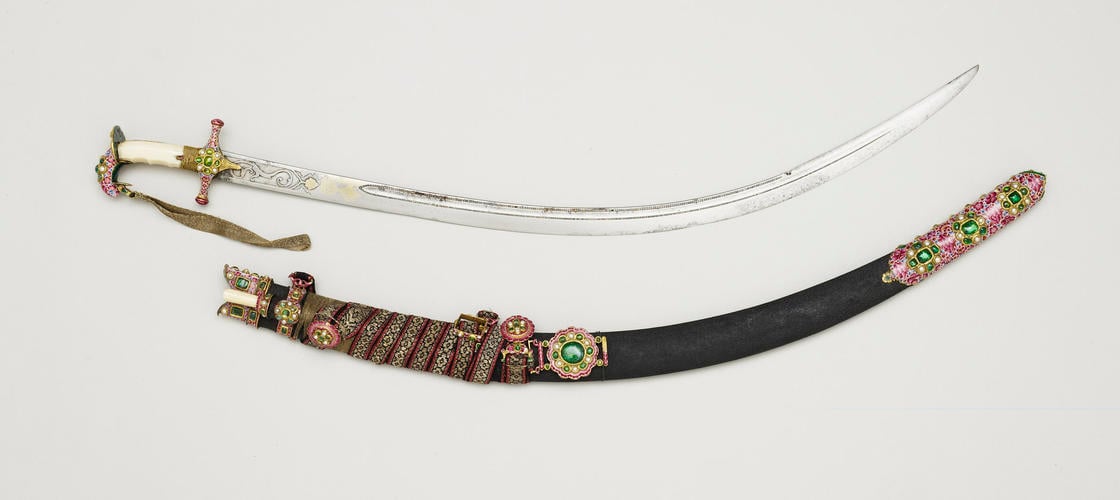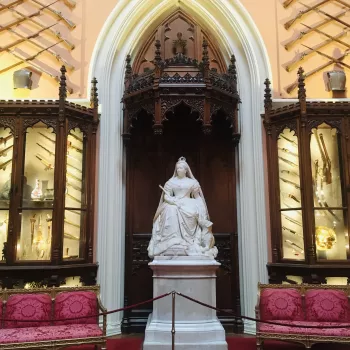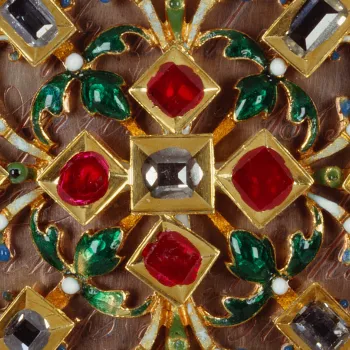Shamshir (sabre), scabbard, bi-knife and sword belt c. 1794 - 1800
Blade, inlaid with Persian couplets and dedications, watered crucible steel, seed pearls, gold; hilt, ivory, gold, enamel, pearls; scabbard, wood, fish-skin; belt, canvas, gold thread; mounts, enamel, gold, emeralds, pearls | RCIN 62883
-
George IV's remarkable assemblage of arms and equipment of European origin was rivalled by his impressive collection of weapons from further afield. His collection of Persian sword blades was described by Sir Gore Ouseley, British Ambassador to Persian as 'certainly the finest Collection of Ancient Persian Swords in the world'.
This watered steel blade is deeply curved and single-edged for most of its length. At the back are a pair of channels containing seed pearls, and at the forte the blade is carved with scrolling lotus buds. The hilt is of Iranian type, but with short quillons, ivory grips and a pommel in the form of a stylised elephant's head holding a loop for the sword knot under its trunk. The wooden scabbard is covered with black shagreen. It is fitted with a throat, chape and two suspension loops, the forward one housing the scabbard for a by-knife (kard). The straps and belt are of black canvas embroidered in gold with red borders, and fitted with strap terminals and a clasp. All the mounts are en suite, enamelled either in blue, pink and white with lotus buds and flowers, or in plain green, and set with a total of 80 emeralds and 69 pearls, all of good quality.
The blade is signed by Kazim of Shiraz (L.A. Mayer, Islamic armourers and their works, Geneva, 1962, p.48, Pl.xn), and is dedicated in the upper of three medallions on the right of the blade 'al-Sultan Aga Muhammad Shah Qajar', the Qajar Shah who established the dynasty, reigning from 1794-7. Ownership of the sword passed to Mir Path Ali Khan Talpur (1783-1801), whose inscription runs beside the back of the blade at the right. Along the back of the blade runs a still later, and less legible, Persian couplet which has not been read. The blade was probably mounted at Hyderabad.
Another closely comparable Talpur shamshir, the blade of which is by Muqim b. Muhammad Zaman of Isfahan, is in the Wallace Collection (OA 1404; Wallace Collection Catalogues.G.F. Laking, Oriental Arms and Armour, London, 1964, pp.7-8; A.V.B. Norman, 'Some princely arms from India and Persia in the Wallace Collection' in Davids Samling, Copenhagen, Islamiske vaben i dansk privateje, 1982, pp.io, 14-15).
Text adapted from Carlton House: The Past Glories of George IV's Palace.Provenance
Belonged to Mir Path 'Ali Khan Talpur (1783-1801); presented to George IV by the Amirs of Sindh (descendants of 'Ali Khan Talpur) in 1822.
Exhibited at the International Exhibition of Persian Art, Royal Academy of Arts London, London, 1931 -
Creator(s)
(nationality)(nationality)Acquirer(s)
-
Medium and techniques
Blade, inlaid with Persian couplets and dedications, watered crucible steel, seed pearls, gold; hilt, ivory, gold, enamel, pearls; scabbard, wood, fish-skin; belt, canvas, gold thread; mounts, enamel, gold, emeralds, pearls
Alternative title(s)
Shamshir and Scabbard











